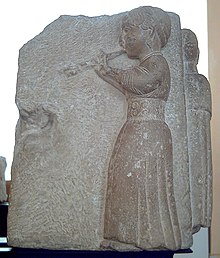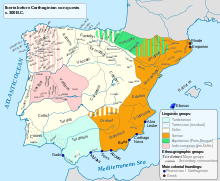Turdetaner

The Turdetaner ( Latin Turdetani ) were an Iberian tribe.
Settlement area
The Turdetans settled in the historic Baetica region in the flat and fertile valley of the Baetis (today Guadalquivir ) as early as pre-Roman times . They already knew ways of refining metals and knew their way around agriculture. The Turdetans were non-warlike and educated. Already Herodotus mentions the Turdetani and describes it as a civilized and well-mannered. The Turdetans are said to have had a written legal system. Strabo speculated that the Turdetans followed the Tartessians and that their language was similar to Tartessian .
The Turdetans took over their language and culture soon after their submission to the Romans.
history
The tribe faced at the Battle of the Río Tinto with other Iberian and perhaps also Celtiberian groups Hamilkar Barkas after his landing in 237 BC. In Nadir ( Cádiz ). Hamilkar was the father of Hannibal , who in 218 BC Moved across the Alps. But Hamilkar overcame the Rio Tinto and was able to penetrate to the mouth of the Baetis. Along the Baetis there must have been scattered but densely populated areas that kept little contact with one another, so that the Carthaginians had it easy to occupy the Baetis Valley. Upstream there are silver mines and mines for other ores, the economic exploitation of which Hamilkar intended to pay the reparations from the lost First Punic War to the Roman Empire. This campaign was also very important for his further project to conquer other parts of the Iberian Peninsula.
In 197 BC The Turdetans rose against the governor appointed by Rome. In 195 BC The general and consul Marcus Porcius Cato the Elder put an end to the revolt of the Turdetans, the "last militant tribe in Hispania".
Individual evidence
- ↑ Entry in Pierer's Universal Lexikon at zeno.org
- ^ Strabo: Geographika III, 2, 12-13
- ^ Titus Livius : Roman History , 34.17
